[XENEA Wallet] Daily Quiz August Answers and Trivia! ✨️ updated daily ✨️

👉July Answers and Trivia
👉Jun Answers and Trivia
👉May Answers and Trivia
👉April Answers and Trivia
👉March Answers and Trivia
👉February Answers and Trivia
👉January Answers and Trivia
XENEA Wallet features a Daily Quiz that enhances user engagement while offering a fun and gamified way to learn about Web3 and the Xenea ecosystem.
Although many kind individuals are sharing answers on X (formerly Twitter), it feels like the quiz is turning into a game of simply picking the right answer without understanding the questions. To address this, this article will provide not only the answers to XENEA Wallet’s Daily Quiz but also the reasoning behind them and additional insights. By leveraging XENEA Wallet NAVI (ChatGPT), we aim to make the experience more informative and meaningful.
It takes less than a minute, so bookmark this page and check back daily! 😊
Start Your Journey with XENEA Wallet Today!
XENEA Wallet is an innovative app that makes exploring the world of Web3 both fun and rewarding! Complete simple missions, claim daily bonuses, and earn rewards while learning about the future of digital technology.
With cutting-edge security and unparalleled convenience, XENEA Wallet offers you the chance to participate in future airdrops and mining opportunities. Simply download the app to begin your new digital experience!
New users can start with 1,000 gems by signing up with the invite code below!
1️⃣ Download the app
2️⃣ Enter the invite code: h3dYzHejPI
3️⃣ Sign up with your Google or Apple account
Enjoy the exciting world of XENEA Wallet!
Please refer to the following page for information on how to earn Gems.
How many days does it take to earn 10,000 gems and start automatic mining with the XENEA Wallet?
Daily Quiz on August 31
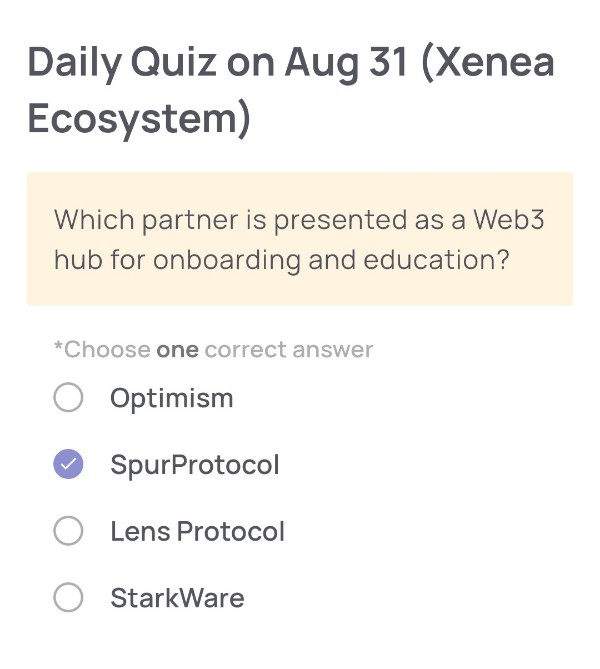
(Xenea Ecosystem)
🟢Quiz Question:
Which partner is presented as a Web3 hub for onboarding and education?
🟢Choose one correct answer:
・Optimism
・SpurProtocol
・Lens Protocol
・StarkWare
🟢Answer:
SpurProtocol
🟢 Reason for choosing this answer:
According to the official Xenea ecosystem updates, SpurProtocol is highlighted as the partner acting as a Web3 hub for onboarding and education. While other options (such as Optimism or StarkWare) focus primarily on scalability solutions, SpurProtocol is specifically positioned to help bring new users into Web3 by providing structured onboarding, educational resources, and a community-driven gateway. This aligns with Xenea’s vision of making blockchain technology more accessible.
🟢 Trivia:
SpurProtocol is known for creating community-centric initiatives that simplify Web3 entry for beginners. Its focus is not just on technology but also on user education, offering guides, tutorials, and interactive learning environments. By doing so, SpurProtocol plays a key role in reducing the barrier to entry for new blockchain users, complementing Xenea’s broader mission of building inclusive infrastructure.
Daily Quiz on August 30
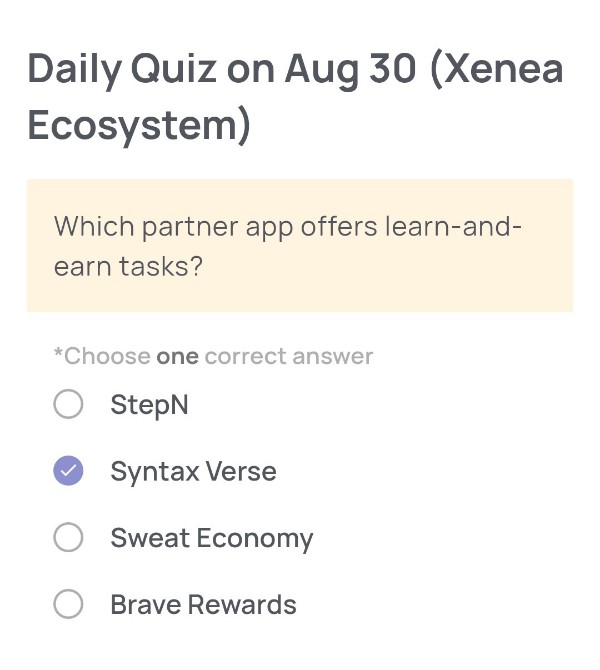
(Xenea Ecosystem)
🟢Quiz Questions:
Which partner app offers learn-and-earn tasks?
🟢Choose one correct answer:
・StepN
・Syntax Verse
・Sweat Economy
・Brave Rewards
🟢Answer:
Syntax Verse
🟢Reason for choosing this answer:
Among Xenea’s ecosystem partners, Syntax Verse is specifically known for offering learn-and-earn tasks, where users can complete educational missions and receive rewards through XENEA Wallet. The other options (StepN, Sweat Economy, Brave Rewards) are also popular Web3 apps, but they focus on different models—StepN on move-to-earn, Sweat Economy on fitness-based rewards, and Brave Rewards on ad-based incentives.
🟢Trivia:
“Learn-and-earn” models are becoming increasingly popular in Web3 because they incentivize education with rewards. This approach not only helps users earn tokens but also increases blockchain literacy and ecosystem adoption. Many leading Web3 projects are now integrating learn-and-earn features to onboard newcomers more effectively.
Daily Quiz on August 29
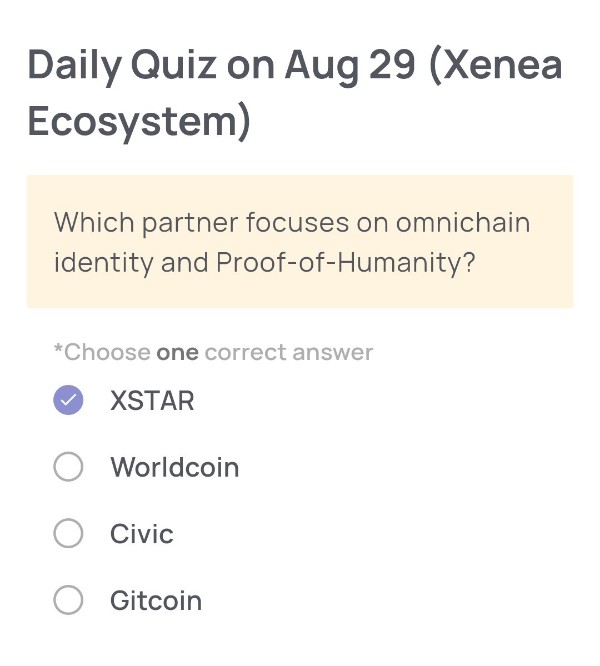
(Xenea Ecosystem)
🟢Quiz Questions:
Which partner focuses on omnichain identity and Proof-of-Humanity?
🟢Choose one correct answer:
・XSTAR
・Worldcoin
・Civic
・Gitcoin
🟢Answer:
XSTAR
🟢Reason for choosing this answer:
Xenea announced a strategic partnership with XSTAR, highlighting its role in developing decentralized identity protocols. Specifically, XSTAR’s Omnichain Identity Protocol is designed for Proof of Humanity (PoH), integrating an adaptive humanity scoring system to ensure users are real and unique, addressing synthetic identities and AI-generated fraud.
🟢Trivia:
XSTAR uses Decentralized Identity Identifiers (DIDs) and combines biometric verification, social linkage, and social graph analysis to enhance identity verification. This makes it a powerful tool in combating Sybil attacks and fake identities in Web3. By collaborating with Xenea, it ensures that omnichain identity and PoH mechanisms can be applied across multiple platforms, paving the way for a safer and more interoperable decentralized ecosystem.
Daily Quiz on August 28
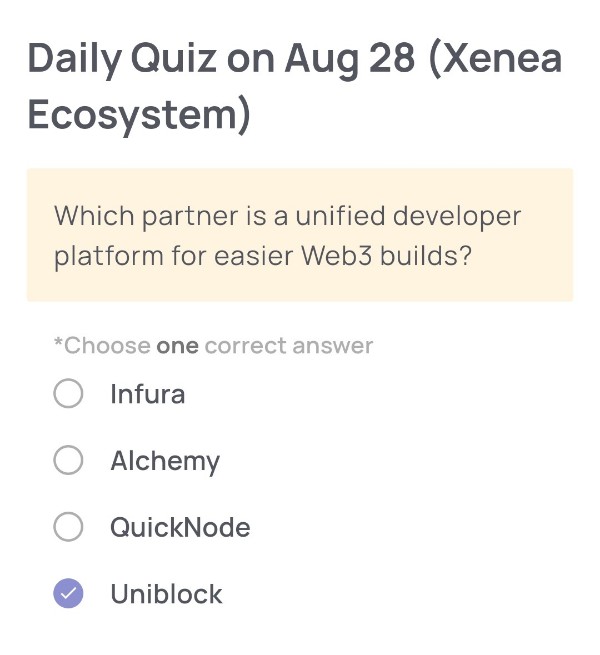
(Xenea Ecosystem)
🟢Quiz Question:
Which partner is a unified developer platform for easier Web3 builds?
🟢Choose one correct answer:
・Infura
・Alchemy
・QuickNode
・Uniblock
🟢Answer:
Uniblock
🟢 Reason for choosing this answer:
Uniblock is positioned as a unified developer platform that simplifies Web3 development by providing APIs and tools that integrate multiple blockchain services in one place. Unlike Infura, Alchemy, and QuickNode—which are primarily infrastructure providers offering RPC endpoints and blockchain node access—Uniblock focuses on giving developers a single platform to connect different Web3 tools, making it easier to build dApps without managing multiple integrations.
🟢 Trivia:
Uniblock is often called the “Zapier for Web3” because it aggregates and unifies APIs from various blockchain services, enabling faster prototyping and easier scaling for decentralized apps. By contrast, Infura (from ConsenSys) is best known for Ethereum node infrastructure, Alchemy provides powerful Web3 APIs with reliability enhancements, and QuickNode emphasizes speed and multi-chain support. Uniblock stands out by unifying these types of services into one platform.
Daily Quiz on August 27
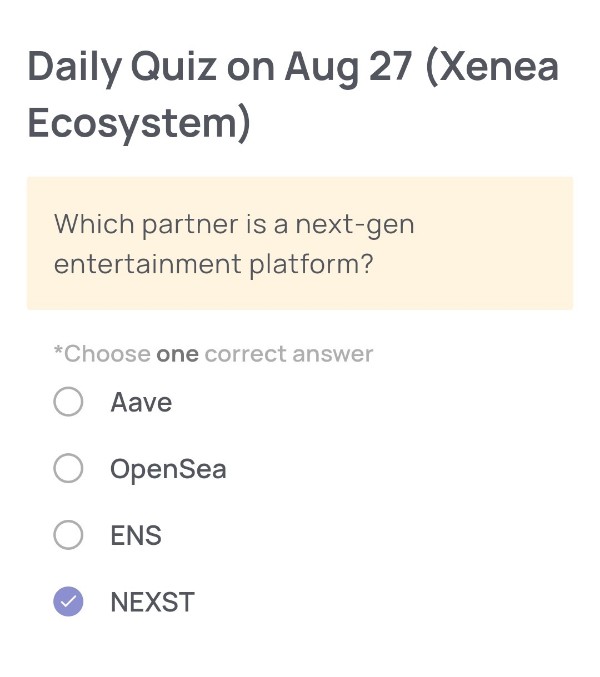
(Xenea Ecosystem)
🟢Quiz Questions:
Which partner is a next-gen entertainment platform?
🟢Choose one correct answer:
・Aave
・OpenSea
・ENS
・NEXST
🟢Answer:
NEXST
🟢Reason for choosing this answer:
Among the listed options, NEXST is positioned as a next-generation entertainment platform within the Xenea ecosystem. Aave is known as a DeFi lending protocol, OpenSea is the largest NFT marketplace, and ENS (Ethereum Name Service) provides decentralized domain naming. Only NEXST directly aligns with entertainment, making it the correct answer.
🟢Trivia:
NEXST is focused on merging blockchain with entertainment, aiming to provide immersive digital experiences powered by Web3 technologies. Unlike traditional entertainment platforms, it emphasizes user ownership of digital assets (NFTs, fan tokens, etc.) and decentralized content distribution. This trend reflects the broader movement in Web3, where communities actively participate in shaping entertainment ecosystems rather than being passive consumers.
Daily Quiz on August 26
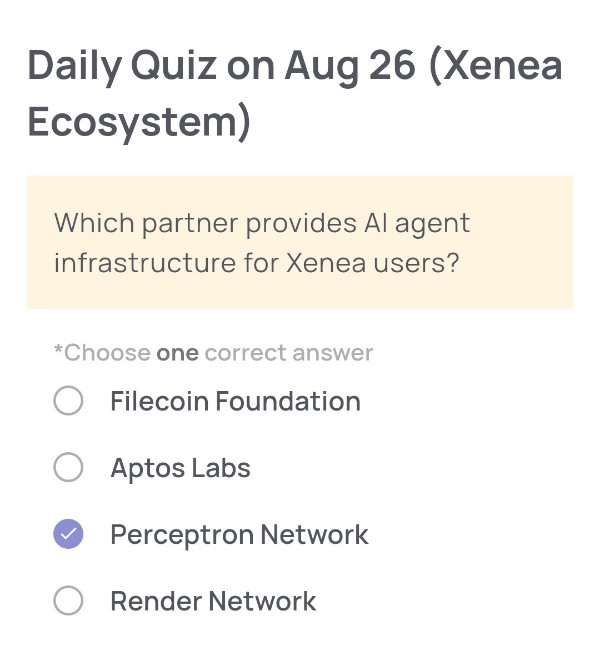
(Xenea Ecosystem)
🟢Quiz Questions:
Which partner provides Al agent infrastructure for Xenea users?
🟢Choose one correct answer:
・Filecoin Foundation
・Aptos Labs
・Perceptron Network
・Render Network
🟢Answer:
Perceptron Network
🟢Reason for choosing this answer:
Perceptron Network is a partner of Xenea that focuses on decentralized AI agent infrastructure. Within the Xenea ecosystem, Perceptron provides the framework enabling users to leverage AI-driven interactions, automation, and decision-making processes. The other options (Filecoin Foundation, Aptos Labs, Render Network) are strong Web3 and infrastructure providers, but they are not specifically tied to AI agent infrastructure for Xenea.
🟢Trivia:
Perceptron Network is working on creating a global “AI economy” by enabling on-chain, autonomous AI agents. Its integration with ecosystems like Xenea allows for use cases such as automated financial services, smart governance, and user-centric AI tools. Unlike general AI models, Perceptron’s infrastructure emphasizes decentralized ownership and transparency, ensuring that users maintain more control over their data and interactions with AI.
Daily Quiz on August 25
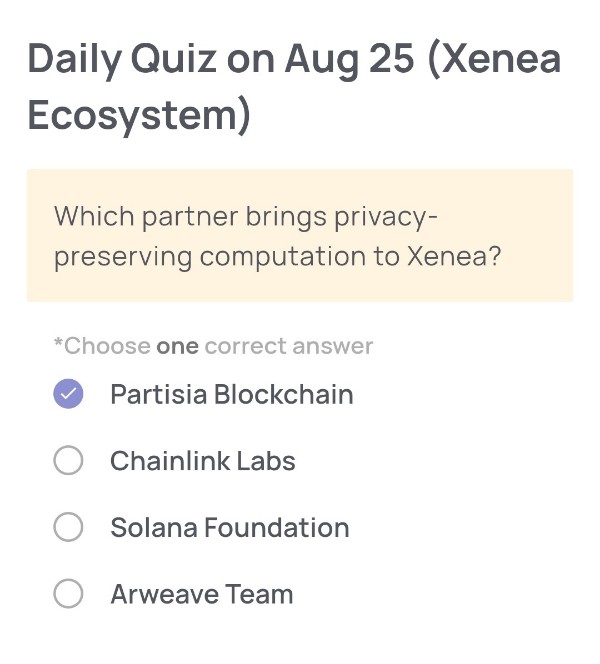
(Xenea Ecosystem)
🟢Quiz Questions:
Which partner brings privacy-preserving computation to Xenea?
🟢Choose one correct answer:
・Partisia Blockchain
・Chainlink Labs
・Solana Foundation
・Arweave Team
🟢Answer:
Partisia Blockchain
🟢 Reason for choosing this answer:
Partisia Blockchain is well-known for its expertise in privacy-preserving computation through multiparty computation (MPC) technology. In the Xenea ecosystem, this partnership focuses on integrating privacy features into decentralized applications and transactions. This ensures sensitive data can be processed securely without exposing it, which aligns directly with the question.
🟢 Trivia:
Partisia Blockchain was founded by cryptographers who have been researching secure multiparty computation since the 1980s. Their technology allows computations on encrypted data, which means organizations and users can collaborate and analyze data while keeping it private. This approach is especially relevant in DeFi and Web3, where transparency and privacy must coexist.
Daily Quiz on August 24
(DePIN)
🟢Quiz Questions:
Xenea is a DePIN project primarily for what service?
🟢Choose one correct answer:
・Ride sharing
・Decentralized storage
・Social networking
・Video streaming
🟢Answer:
Decentralized storage
🟢Reason for choosing this answer:
Xenea is designed as a decentralized infrastructure project that focuses on secure and distributed data storage. Its ecosystem leverages POD (Proof of Democracy) consensus and XENE tokens to allow users to store, share, and manage data across a decentralized network, making it part of the DePIN (Decentralized Physical Infrastructure Network) category. Unlike ride sharing, social networking, or video streaming, its core utility is ensuring safe, tamper-resistant, and transparent data storage.
🟢Trivia:
DePIN projects are a rising trend in Web3, where blockchain is used to power real-world infrastructure such as storage, compute, bandwidth, and energy grids. Famous examples include Filecoin (storage), Helium (wireless networks), and Render (GPU rendering). Xenea joins this category by focusing on decentralized storage with added democratic governance through its unique POD consensus, setting it apart from traditional blockchain storage solutions.
Daily Quiz on August 23
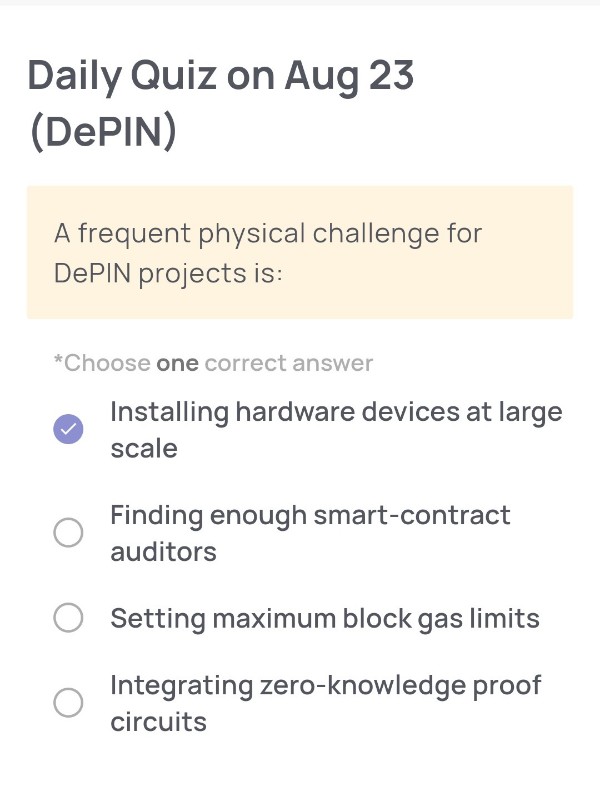
(DePIN)
🟢Quiz Question:
A frequent physical challenge for DePIN projects is:
🟢Choose one correct answer:
・Installing hardware devices at large scale
・Finding enough smart-contract auditors
・Setting maximum block gas limits
・Integrating zero-knowledge proof circuits
🟢Answer:
Installing hardware devices at large scale
🟢 Reason for choosing this answer:
DePIN (Decentralized Physical Infrastructure Networks) projects rely on real-world physical infrastructure, such as IoT sensors, wireless hotspots, or storage devices, to operate. Unlike purely digital blockchain protocols, their biggest challenge is deploying and maintaining hardware at scale. This requires logistics, supply chain coordination, physical installation, and sometimes regulatory approval. The other options—like smart contract auditing, gas limits, or ZK circuits—are more relevant to purely on-chain protocols, not DePIN’s physical layer.
🟢 Trivia:
One of the most famous DePIN projects is Helium, which built a decentralized wireless network by incentivizing individuals to set up physical hotspots. By mid-2023, over 1 million hotspots were deployed globally. This showcases the potential scale of DePIN but also highlights the challenges—ensuring proper distribution, dealing with faulty hardware, and preventing fraudulent deployments remain key hurdles.
Daily Quiz on August 22
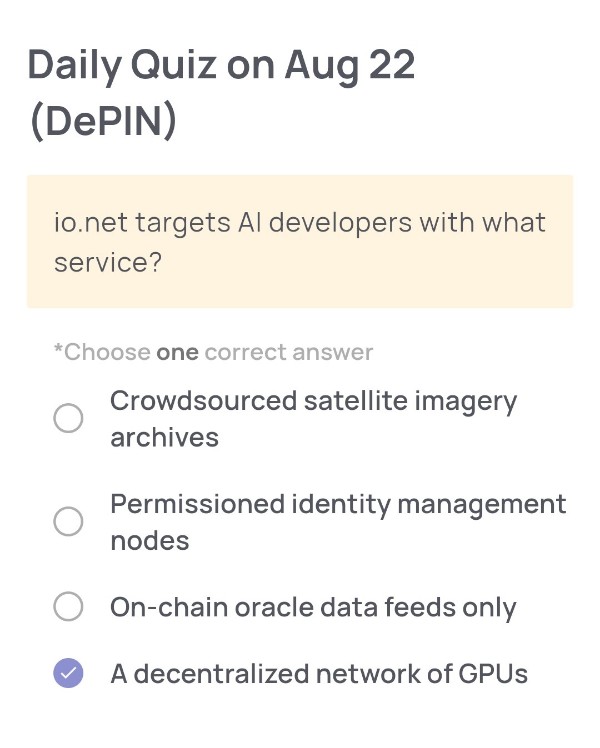
(DePIN)
🟢Quiz Question:
io.net targets AI developers with what service?
🟢Choose one correct answer:
・Crowdsourced satellite imagery archives
・Permissioned identity management nodes
・On-chain oracle data feeds only
・A decentralized network of GPUs
🟢 Answer:
A decentralized network of GPUs
🟢 Reason for choosing this answer:
io.net is well‐known as a DePIN (Decentralized Physical Infrastructure Network) project that provides AI and machine learning developers with access to GPU compute power through a decentralized network. It aggregates underutilized GPUs from independent data centers, crypto miners, consumer GPUs, and more—allowing AI workloads to be executed at a fraction of the cost compared to centralized providers like AWS.
🟢Trivia:
・io.net often emphasizes that it is a decentralized GPU cloud network, pooling idle GPUs globally to enable scalable and cost-effective compute resources for AI/ML tasks.
・For example, according to CoinMarketCap’s explanation: “io.net (IO) is a decentralized GPU network providing scalable, affordable computing power for AI/ML applications by aggregating global hardware resources.”.
Daily Quiz on August 21

(DePIN)
🟢Quiz Questions:
What technology forms the backbone for trust in DePINs?
🟢Choose one correct answer:
・Internet of Things
・Cloud Computing
・Artificial Intelligence
・Blockchain
🟢Answer:
Blockchain
🟢 Reason for choosing this answer:
Decentralized Physical Infrastructure Networks (DePINs) rely on blockchain to establish trust among participants who don’t necessarily know or trust each other. Blockchain provides immutability, transparency, and decentralized consensus, which ensure that contributions (such as bandwidth, storage, or computing power) are verifiable and fairly rewarded. Without blockchain, DePINs would struggle to coordinate incentives and maintain a secure, tamper-resistant record of contributions.
🟢 Trivia:
The concept of DePINs has rapidly grown since 2021, with projects like Helium (for decentralized wireless networks) and Filecoin (for decentralized storage) being prime examples. Analysts predict that the DePIN market could become a trillion-dollar industry by 2030, as blockchain enables real-world infrastructure to be shared, monetized, and managed without relying on centralized entities.
Daily Quiz on August 20
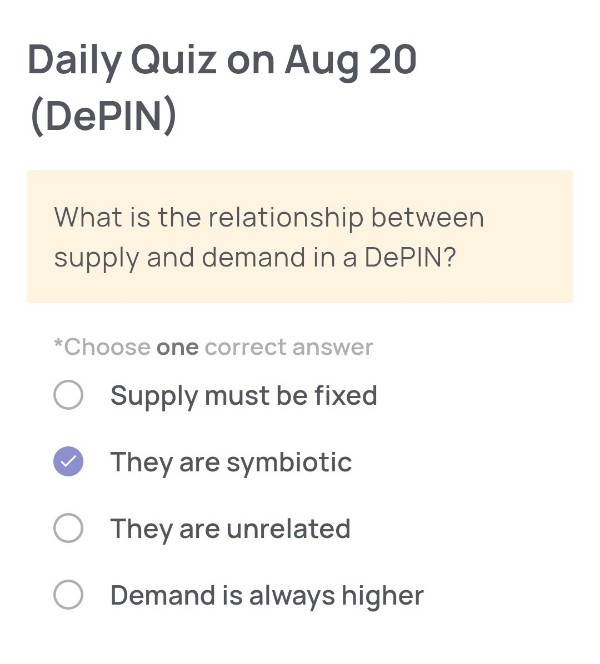
(DePIN)
🟢Quiz Questions:
What is the relationship between supply and demand in a DePIN?
🟢Choose one correct answer:
・Supply must be fixed
・They are symbiotic
・They are unrelated
・Demand is always higher
🟢Answer:
They are symbiotic
🟢 Reason for choosing this answer:
In a DePIN (Decentralized Physical Infrastructure Network), supply and demand are interdependent and evolve together. Supply (resources like bandwidth, storage, or compute power provided by participants) grows when there is strong demand, and demand increases as more supply becomes available and cost-effective. This creates a self-reinforcing cycle where both supply and demand balance each other in a decentralized marketplace.
🟢 Trivia:
A good example of this dynamic can be seen in decentralized storage networks like Filecoin or Xenea’s DACS (Decentralized Autonomous Content Storage). When more users demand secure storage, more node operators provide supply, incentivized by rewards. Conversely, when supply grows, storage costs decrease, attracting more demand. This symbiotic relationship is what makes DePINs scalable and sustainable in the long run.
Daily Quiz on August 19
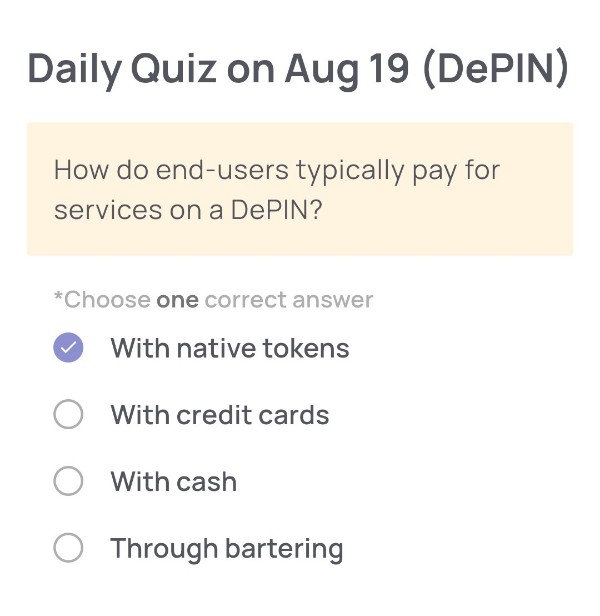
(DePIN)
🟢Quiz Questions:
How do end-users typically pay for services on a DePIN?
🟢Choose one correct answer:
・With native tokens
・With credit cards
・With cash
・Through bartering
🟢Answer:
With native tokens
🟢 Reason for choosing this answer:
DePIN (Decentralized Physical Infrastructure Networks) are blockchain-based networks where physical infrastructure is provided in a decentralized way (such as wireless networks, storage, or computing). Since these services are run on decentralized blockchains, the economic model is powered by their native tokens. End-users typically pay for access to resources (bandwidth, storage, compute, etc.) using these tokens, which ensures that value flows directly to the providers maintaining the infrastructure. This aligns incentives and secures the network economy.
🟢 Trivia:
One of the best-known examples of DePIN is Helium Network, where users pay for wireless data usage in the native token HNT. Similarly, Filecoin users pay for decentralized storage with FIL tokens. This native-token model ensures transparency, trustlessness, and decentralization—removing reliance on centralized intermediaries like credit card processors. Over time, some DePINs also integrate fiat on-ramps (e.g., credit cards) for convenience, but the core settlement always happens in native tokens.
Daily Quiz on August 18
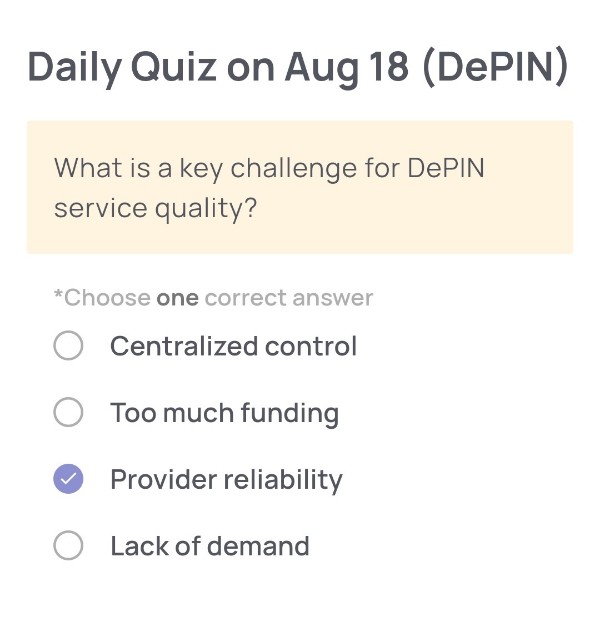
(DePIN)
🟢Quiz Questions:
What is a key challenge for DePIN service quality?
🟢Choose one correct answer:
・Centralized control
・Too much funding
・Provider reliability
・Lack of demand
🟢Answer:
Provider reliability
🟢 Reason for choosing this answer:
DePIN (Decentralized Physical Infrastructure Networks) relies on many independent providers to contribute real-world infrastructure such as storage, bandwidth, or sensors. Since these providers vary in resources, stability, and incentives, service reliability becomes the most significant challenge. If providers frequently go offline or fail to meet performance standards, the overall network quality declines, regardless of decentralization or demand.
🟢 Trivia:
A well-known example of DePIN is Helium Network, where individual users provide wireless hotspots. While it attracted massive growth, one of the biggest challenges has been ensuring consistent uptime and reliability of these hotspots. To address this, many DePIN projects now integrate staking, reputation systems, and token incentives to encourage providers to maintain higher service quality. This highlights that decentralized infrastructure isn’t just about growth, but also about long-term reliability and trust.
Daily Quiz on August 17
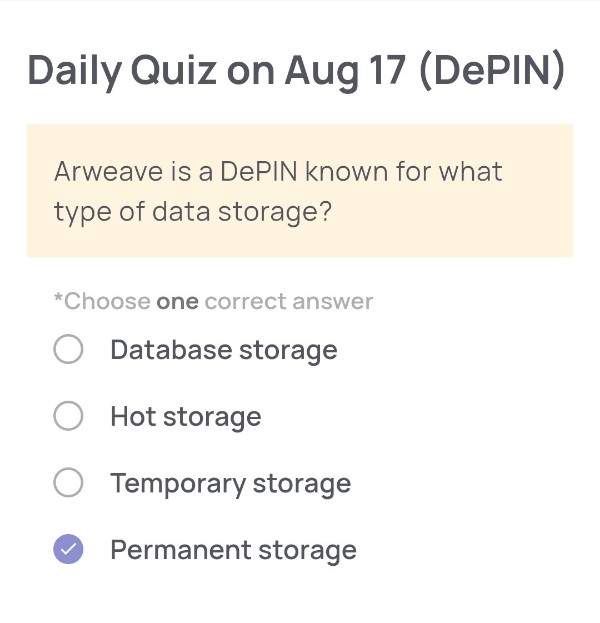
(DePIN)
🟢Quiz Questions:
Arweave is a DePIN known for what type of data storage?
🟢Choose one correct answer:
・Database storage
・Hot storage
・Temporary storage
・Permanent storage
🟢Answer:
Permanent storage
🟢 Reason for choosing this answer:
Arweave is designed as a decentralized storage network where data, once uploaded, is stored permanently. Unlike traditional cloud storage (which relies on subscription models and may delete data when payments stop), Arweave uses an endowment mechanism that incentivizes miners to store data indefinitely. This makes it unique as a DePIN project focusing on long-term, immutable storage.
🟢 Trivia:
Arweave refers to its storage system as the “permaweb”, a permanent, decentralized web where websites, apps, and files are stored forever. Once uploaded, the data cannot be altered or deleted, making it ideal for preserving historical records, academic research, and cultural archives. Interestingly, the cost of storing data on Arweave is paid upfront, calculated to cover storage for potentially hundreds of years.
Daily Quiz on August 16

(DePIN)
🟢Quiz Questions:
What is the primary role of the blockchain in a DePIN?
🟢Choose one correct answer:
・To track rewards
・To create a website
・To market the project
・To design hardware
🟢Answer:
To track rewards
🟢 Reason for choosing this answer:
In a Decentralized Physical Infrastructure Network (DePIN), blockchain technology is primarily used to record and verify the contribution of participants, ensuring transparency and fairness in reward distribution. The immutable ledger allows accurate tracking of usage data, service provision, and corresponding incentives without relying on a centralized authority.
🟢 Trivia:
The concept of DePIN merges blockchain with real-world infrastructure like IoT devices, storage networks, or wireless hotspots. For example, in a decentralized wireless network, blockchain records how much coverage each node provides, and rewards are automatically calculated. This trustless mechanism eliminates disputes and enables global participation, making large-scale infrastructure projects possible without traditional corporate control.
Daily Quiz on August 15
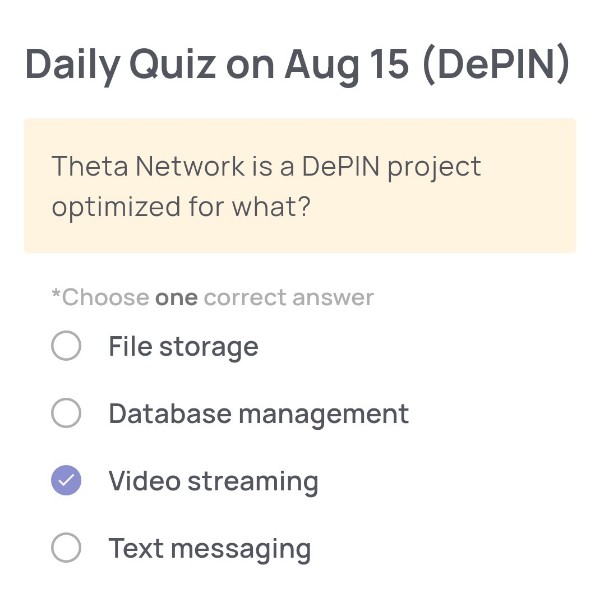
(DePIN)
🟢Quiz Questions:
Theta Network is a DePIN project optimized for what?
🟢Choose one correct answer:
・File storage
・Database management
・Video streaming
・Text messaging
🟢Answer:
Video streaming
🟢Reason for choosing this answer:
Theta Network is designed to improve the efficiency and cost-effectiveness of delivering high-quality video content. It leverages a decentralized network of nodes that share bandwidth and computing resources, making it ideal for video streaming applications, including live streaming and video-on-demand.
🟢Trivia:
Theta’s decentralized streaming infrastructure allows users to share their unused bandwidth in exchange for rewards, improving video delivery speeds while lowering costs for content platforms. Major partnerships, including those with Samsung and Google, have helped Theta position itself as a leader in decentralized media streaming technology.
Daily Quiz on August 14
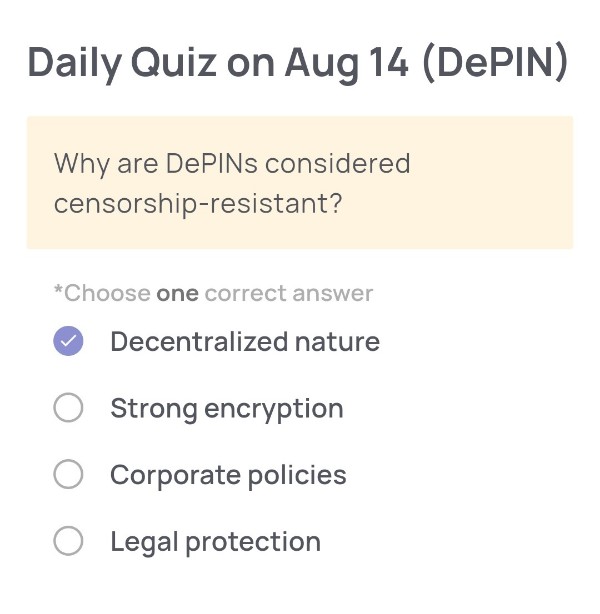
(DePIN)
🟢Quiz Questions:
Why are DePINs considered censorship-resistant?
🟢Choose one correct answer:
・Decentralized nature
・Strong encryption
・Corporate policies
・Legal protection
🟢Answer:
Decentralized nature
🟢 Reason for choosing this answer:
DePINs (Decentralized Physical Infrastructure Networks) rely on a distributed network of participants rather than a single centralized authority. This decentralized architecture makes it extremely difficult for any single party—whether a corporation, government, or malicious actor—to control, alter, or block the network’s operations. As a result, no central point of failure exists, and censorship attempts become impractical or ineffective.
🟢 Trivia:
The principle of censorship resistance is one of the same reasons why Bitcoin has survived for over 15 years without a single day of downtime. By spreading infrastructure across numerous independent operators worldwide, DePIN projects inherit the same resilience, ensuring that services like file storage, wireless connectivity, or computing power remain accessible even under political or corporate pressure.
Daily Quiz on August 13
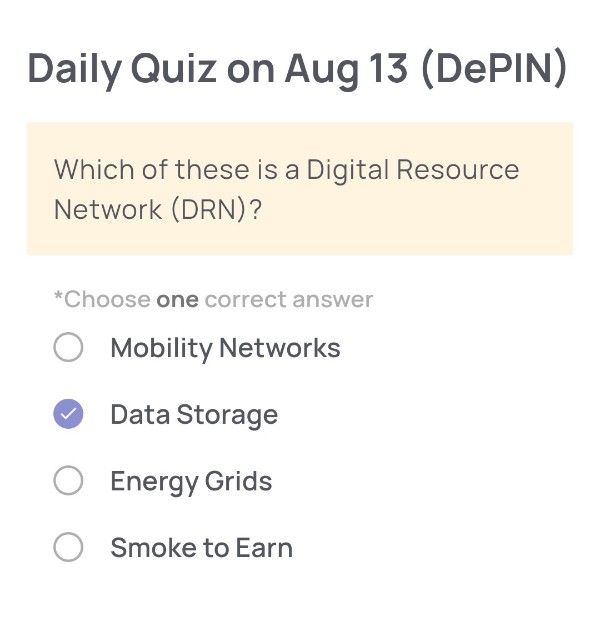
(DePIN)
🟢Quiz Questions:
Which of these is a Digital Resource Network (DRN)?
🟢Choose one correct answer:
・Mobility Networks
・Data Storage
・Energy Grids
・Smoke to Earn
🟢Answer:
Data Storage
🟢Reason for choosing this answer:
In the context of DePIN (Decentralized Physical Infrastructure Networks), a Digital Resource Network (DRN) refers to networks that manage and provide access to digital resources—such as decentralized storage or computing—rather than physical assets like transportation or power grids. Data Storage is a direct example of a DRN because it involves distributed digital infrastructure, often powered by blockchain, that allows secure, persistent, and verifiable storage of information.
🟢Trivia:
Decentralized storage networks like Xenea’s DACS (Decentralized Autonomous Content Storage) or IPFS ensure data persistence without relying on a single company’s server. Xenea’s DACS even uses a Sustainable Generation Manager to periodically move data to new storage nodes to prevent loss over decades, making it well-suited for storing important digital assets for future generations. This type of infrastructure is a textbook example of a DRN.
Daily Quiz on August 12
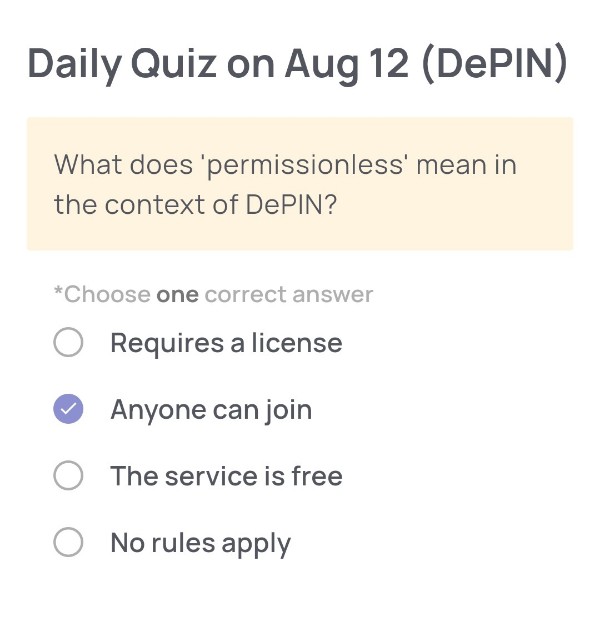
(DePIN)
🟢Quiz Questions:
What does ‘permissionless’ mean in the context of DePIN?
🟢Choose one correct answer:
・Requires a license
・Anyone can join
・The service is free
・No rules apply
🟢Answer:
Anyone can join
🟢Reason for choosing this answer:
In the context of DePIN (Decentralized Physical Infrastructure Networks), “permissionless” refers to a system or network where participation is open to anyone without needing prior approval or special authorization. This openness fosters decentralization and wider participation, enabling more contributors to build, maintain, and benefit from the network.
🟢Trivia:
Permissionless systems are a cornerstone of blockchain philosophy, ensuring that innovation and participation are not limited to a select group. Bitcoin and Ethereum are classic examples—anyone with an internet connection can run a node or deploy a smart contract without asking for permission. This approach contrasts with “permissioned” systems, where a central authority controls who can join or validate transactions.
Daily Quiz on August 11
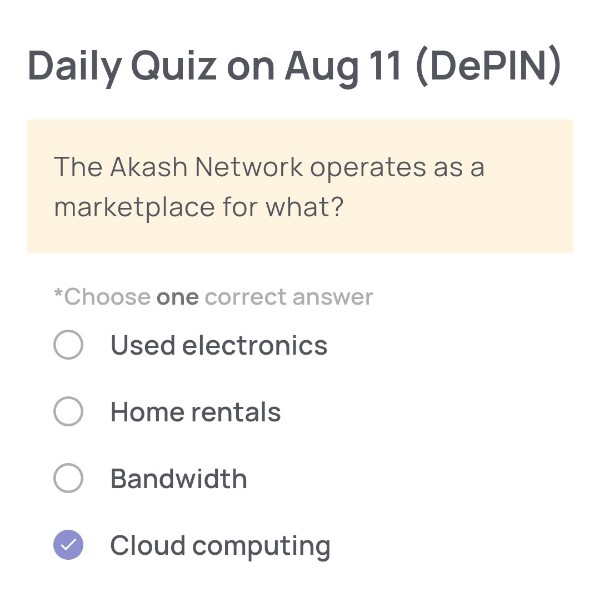
(DePIN)
🟢Quiz Questions:
The Akash Network operates as a marketplace for what?
🟢Choose one correct answer:
・Used electronics
・Home rentals
・Bandwidth
・Cloud computing
🟢Answer:
Cloud computing
🟢 Reason for choosing this answer:
Akash Network is known as a decentralized cloud computing marketplace. It connects providers with underutilized computing resources to users who need them, enabling a more open and cost-effective alternative to traditional cloud services like AWS or Google Cloud.
🟢 Trivia:
Akash Network runs on the Cosmos ecosystem and uses a bidding model where compute providers compete to offer the lowest price. This allows developers to deploy apps and services at potentially much lower costs, while also utilizing unused server capacity worldwide—kind of like an “Airbnb for cloud servers.”
Daily Quiz on August 10
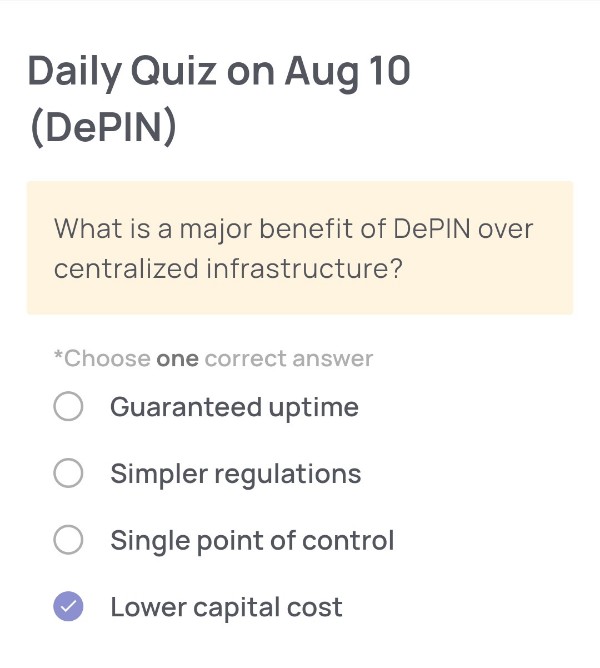
(DePIN)
🟢Quiz Questions:
What is a major benefit of DePIN over centralized infrastructure?
🟢Choose one correct answer:
・Guaranteed uptime
・Simpler regulations
・Single point of control
・Lower capital cost
🟢Answer:
Lower capital cost
🟢 Reason for choosing this answer:
DePIN (Decentralized Physical Infrastructure Networks) leverages distributed resources contributed by individuals or small operators, avoiding the massive upfront investment required for centralized infrastructure. By crowdsourcing hardware and services, DePIN projects can grow with significantly reduced capital expenditure compared to traditional centralized systems.
🟢 Trivia:
A well-known example of DePIN is Helium Network, where individuals deploy wireless hotspots and earn tokens for providing network coverage. This model lowers the need for a central company to build and maintain all infrastructure, enabling faster scaling and making global coverage feasible without billions in initial funding.
Daily Quiz on August 10
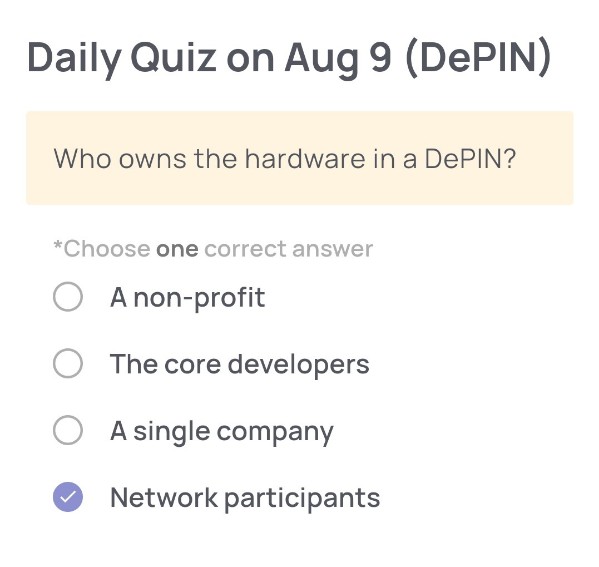
(DePIN)
🟢Quiz Questions:
Who owns the hardware in a DePIN?
🟢Choose one correct answer:
・A non-profit
・The core developers
・A single company
・Network participants
🟢Answer:
Network participants
🟢Reason for choosing this answer:
In a DePIN (Decentralized Physical Infrastructure Network), the key innovation lies in distributing the ownership and operation of physical infrastructure—such as hardware, sensors, or devices—across a wide range of independent participants. Rather than being centrally owned by a corporation or foundation, these devices are contributed by individuals or organizations within the network. This ensures decentralization, redundancy, and resilience, and aligns incentives through token rewards or governance mechanisms.
🟢Trivia:
One of the most famous examples of DePIN is Helium, a decentralized wireless network where individual participants deploy hotspots to expand network coverage. In return, they earn crypto rewards for their contribution to the network. This model has since expanded to cover other infrastructure areas like storage, compute, and energy.
Daily Quiz on August 8

(DePIN)
🟢Quiz Questions:
What is the DePIN ‘flywheel effect’?
🟢Choose one correct answer:
・A hardware failure
・A token price crash
・A self-reinforcing loop
・A network slowdown
🟢Answer:
・A self-reinforcing loop
🟢Reason for choosing this answer:
The “flywheel effect” in the context of DePIN (Decentralized Physical Infrastructure Networks) refers to a positive feedback loop where the growth of network participants and infrastructure leads to more utility, which in turn attracts more participants. As more users and contributors join, the network becomes more valuable, sparking further adoption and expansion — thus, it is a “self-reinforcing loop.”
🟢Trivia:
The flywheel effect is a popular concept in both Web3 and traditional business. In DePIN, projects like Helium (for wireless infrastructure) and Filecoin (for storage) grow stronger as more people contribute hardware, bandwidth, or storage. Their networks improve over time not through central control but through decentralized participation — all powered by aligned token incentives.
Daily Quiz on August 7
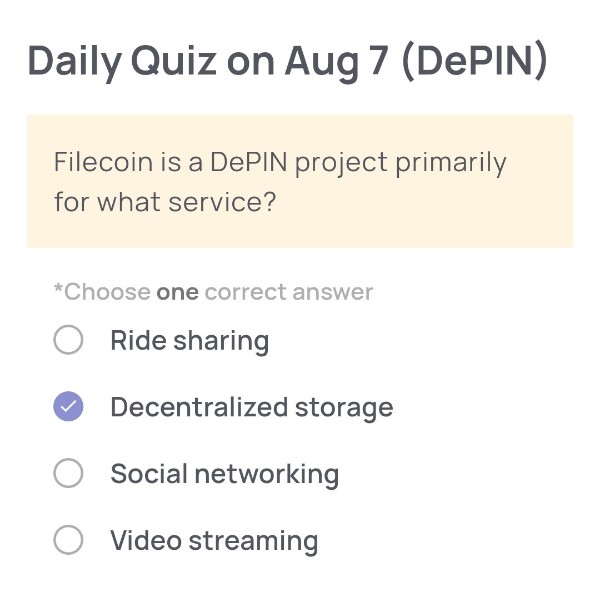
(DePIN)
🟢Quiz Questions:
Filecoin is a DePIN project primarily for what service?
🟢Choose one correct answer:
・Ride sharing
・Decentralized storage
・Social networking
・Video streaming
🟢Answer:
Decentralized storage
🟢Reason for choosing this answer:
Filecoin is fundamentally designed as a decentralized storage network. It incentivizes users to provide storage space using a blockchain-based system. Providers earn Filecoin (FIL) tokens by offering reliable data storage, and clients pay to store their data in a secure and censorship-resistant manner. This makes it a textbook example of a DePIN (Decentralized Physical Infrastructure Network) focused on decentralized storage.
🟢Trivia:
Filecoin builds on IPFS (InterPlanetary File System), a protocol that enables peer-to-peer data sharing. While IPFS handles the data distribution, Filecoin adds economic incentives through blockchain, enabling a decentralized, trustless, and market-driven storage ecosystem. This model aims to disrupt traditional cloud storage services like AWS, Google Cloud, or Dropbox.
Daily Quiz on August 6
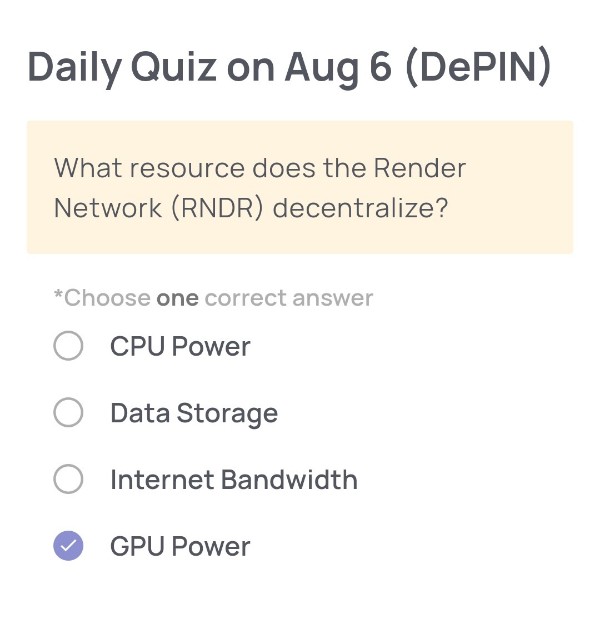
(DePIN)
🟢 Quiz Questions:
What resource does the Render Network (RNDR) decentralize?
🟢 Choose one correct answer:
・CPU Power
・Data Storage
・Internet Bandwidth
・GPU Power
🟢 Answer:
GPU Power
🟢 Reason for choosing this answer:
The Render Network is specifically designed as a decentralized GPU rendering platform. It allows individuals to contribute their idle GPU compute power to the network, enabling creators to outsource 3D rendering jobs or AI‑related GPU workloads in exchange for RNDR tokens. It does not focus on decentralizing CPU cycles, storage capacity, or Internet bandwidth.
🟢 Trivia:
Render Network operates as a peer‑to‑peer GPU marketplace. GPU owners (Node Operators) can monetize otherwise idle graphics cards by rendering motion graphics, visual effects, and even AI tasks for content creators (Creators). The network uses a Proof‑of‑Render mechanism: jobs are verified before RNDR tokens are released as payment to maintain quality and trust. The ecosystem supports popular render engines like OctaneRender and Blender Cycles and is evolving to support more AI workflows and cross‑chain integration (e.g., Solana migration).
Daily Quiz on August 5
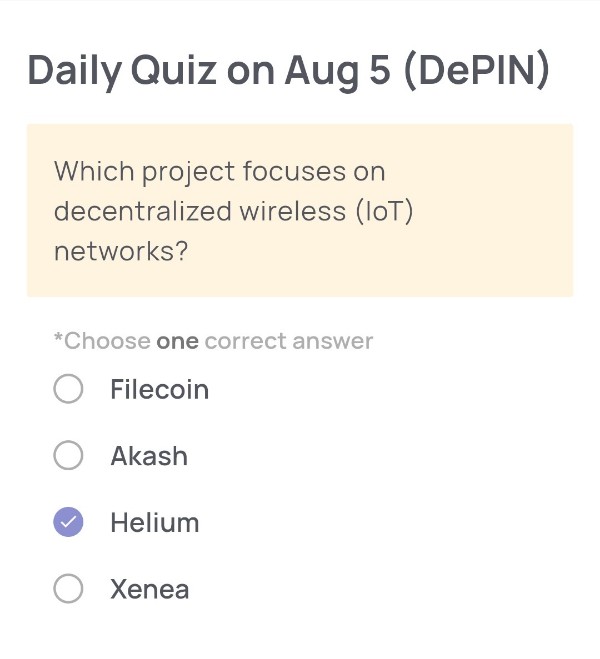
(DePIN)
🟢Quiz Questions:
Which project focuses on decentralized wireless (IoT) networks?
🟢Choose one correct answer:
・Filecoin
・Akash
・Helium
・Xenea
🟢Answer:
Helium
🟢Reason for choosing this answer:
Helium is a decentralized wireless network that provides connectivity for Internet of Things (IoT) devices using a blockchain-based model. It leverages a network of Hotspots—individually owned devices that act as both miners and wireless access points—to create a global, decentralized network. This unique focus on wireless IoT infrastructure clearly differentiates it from the other options.
🟢Trivia:
Helium’s blockchain uses a Proof-of-Coverage (PoC) mechanism to verify the presence and quality of wireless coverage provided by Hotspots. Participants are rewarded with the Helium token (HNT) for maintaining network coverage and transferring data, creating economic incentives for expanding a decentralized wireless infrastructure.
Daily Quiz on August 4
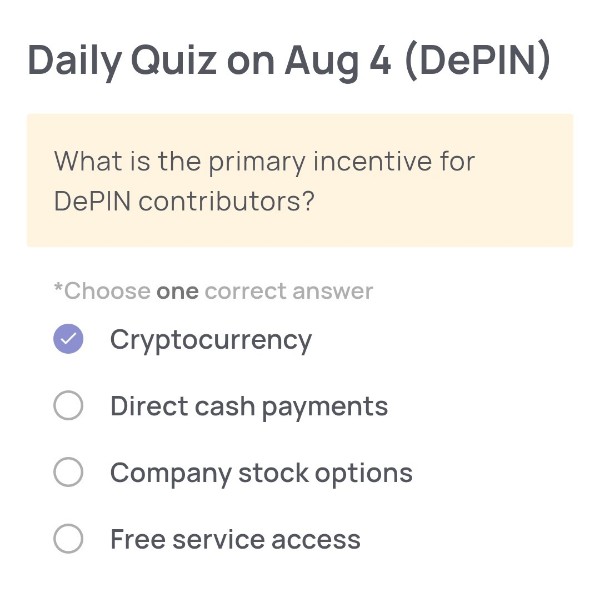
(DePIN)
🟢Quiz Questions:
What is the primary incentive for DePIN contributors?
🟢Choose one correct answer:
・Cryptocurrency
・Direct cash payments
・Company stock options
・Free service access
🟢Answer:
Cryptocurrency
🟢Reason for choosing this answer:
The core mechanism behind DePIN (Decentralized Physical Infrastructure Networks) is to reward contributors—whether they provide bandwidth, storage, or physical infrastructure—with cryptocurrency. This decentralized incentive structure eliminates the need for a central authority and aligns with the Web3 philosophy of using token-based economics to drive participation and growth.
🟢Trivia:
Many DePIN projects, like Helium and Render Network, have pioneered this model. For example, Helium rewards users with HNT tokens for providing wireless network coverage via personal hotspots. These tokens can often be traded on exchanges or used within the ecosystem, giving contributors a tangible incentive to support decentralized infrastructure.
Daily Quiz on August 3
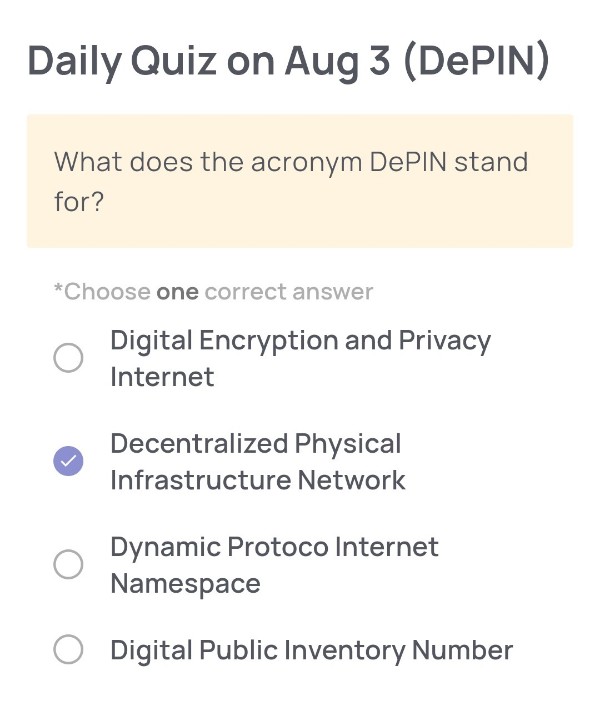
(DePIN)
🟢Quiz Questions:
What does the acronym DePIN stand for?
🟢Choose one correct answer:
・Digital Encryption and Privacy Internet
・Decentralized Physical Infrastructure Network
・Dynamic Protoco Internet Namespace
・Digital Public Inventory Number
🟢Answer:
Decentralized Physical Infrastructure Network
🟢Reason for choosing this answer:
DePIN stands for “Decentralized Physical Infrastructure Network.” It refers to blockchain-based networks that incentivize participants to build and maintain physical infrastructure like sensors, storage devices, wireless networks, or even energy systems. The idea is to decentralize the ownership and operation of traditionally centralized infrastructure, using tokens and smart contracts to coordinate and reward contributions.
🟢Trivia:
One of the most well-known DePIN projects is Helium, which incentivizes users to deploy wireless hotspots to build decentralized wireless networks. DePIN is a growing sector in Web3, enabling the real-world use of blockchain beyond finance by connecting physical infrastructure to decentralized digital ecosystems.
Daily Quiz on August 2
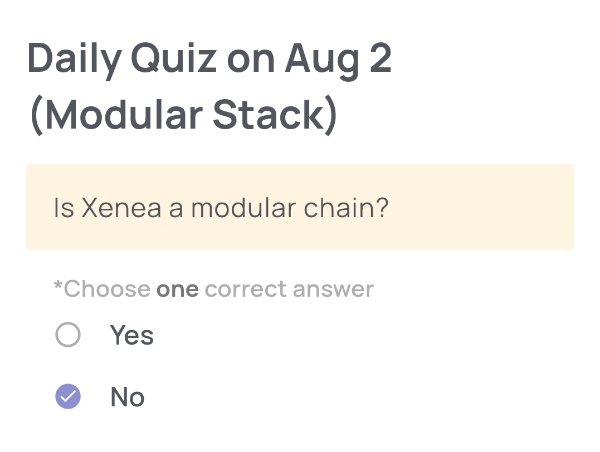
(Modular Stack)
🟢Quiz Questions:
Is Xenea a modular chain?
🟢Choose one correct answer:
・Yes
・No
🟢Answer:
No
🟢Reason for choosing this answer:
Xenea is an EVM-compatible Layer 1 blockchain that integrates its own decentralized storage layer (DACS) and uses its proprietary consensus mechanism called Proof of Democracy (PoD). This means Xenea is built as a monolithic chain rather than a modular chain. Modular chains typically separate functions like execution, consensus, and data availability across different layers or chains. In contrast, Xenea handles these components within a unified Layer 1 architecture.
🟢Trivia:
The modular blockchain design trend is popular in new ecosystems like Celestia or EigenLayer, where different layers specialize in distinct tasks. However, Xenea takes a different approach by combining execution, consensus, and decentralized storage directly into its Layer 1—offering simplicity for developers and ensuring data permanence through its DACS system.
Daily Quiz on August 1
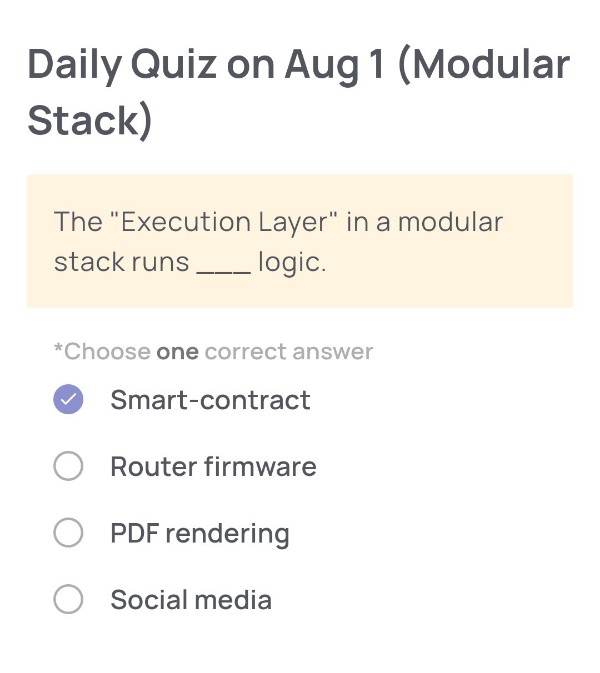
(Modular Stack)
🟢Quiz Questions:
The “Execution Layer” in a modular stack runs logic.
🟢Choose one correct answer:
・Smart-contract
・Router firmware
・PDF rendering
・Social media
🟢Answer:
Smart-contract
🟢Reason for choosing this answer:
In a modular blockchain stack, the Execution Layer is responsible for running the business logic of applications. This includes processing and executing smart contracts — self-executing code that lives on the blockchain and automates agreements between parties. Other options like “Router firmware,” “PDF rendering,” and “Social media” are unrelated to blockchain execution layers and pertain to completely different domains (network hardware, document software, and internet platforms respectively).
🟢Trivia:
The modular blockchain design splits core blockchain functions into separate layers — typically Data Availability, Consensus, and Execution — to improve scalability, flexibility, and specialization. Ethereum is increasingly adopting modular architecture through rollups, where the execution happens off-chain and is later validated on-chain, allowing for significantly higher throughput.
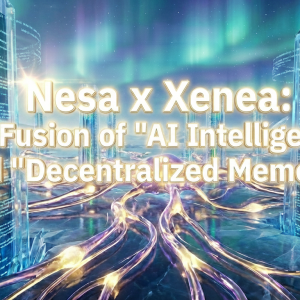
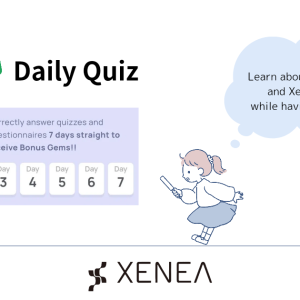
Comment